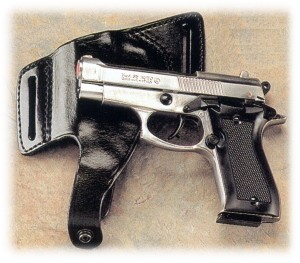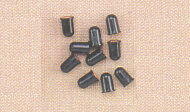The Use and Dangers of Guns in Performance
|
Throughout the history of community theater, the
topic of guns on stage has reared its head over and over again.
Murder mysteries, thrillers, comedies, dramas, even musicals
require this device as an integral part of the plot. Theaters
have used all manner of devices to simulate gunfire on stage,
from toy pistols and sound effects, starter pistols, blank firing
guns and real guns using blanks (very bad idea). In this article,
we’ll delve into the do’s and don’ts of guns
on stage, with an emphasis on safety and security.
Types of Guns for Use on the Stage
- Non-Firing Replica – This is the safest
gun for use on stage. It looks and feels like a real gun, but
cannot chamber a round and will not fire, lacking a firing
pin. Relatively inexpensive, these guns are manufactured from
original blueprints from less robust metals. They can be used
when a gun needs to be displayed on stage but not fired. Safe
as they are, non-firing replicas should still be treated as
real guns and locked up when not in use.
- Blank-Firing Replica (Blank Gun) – This
is a gun built specifically to chamber a blank round. A blank
round
is a shell that does not contain a projectile (bullet). Generally,
these are built from blueprints matching real guns and then
modified to chamber a blank round, usually 8mm, and ported
so that the gasses from firing do not come out of the end of
the barrel, but are shunted out the top or side. Treat them
as if they were a real gun. These come in three basic types:
the revolver and semi-automatic handgun styles, and the
long gun.
- Revolver (below left and right)– This
handgun has a cylinder that holds the blank rounds and rotates
to
bring
them under
the firing pin. Best for use on stage because of its simplicity
and the fact that it does not eject spent shells.

 Semi-Automatic (right) – This
handgun holds its blank rounds in a magazine in the grip
and, when fired, uses a slide powered by expanding gases
to chamber the next round. Unfortunately, this has the effect
of ejecting the spent shell from the gun onto the stage or
even into the audience. Care should be taken when using this
type of gun on stage as the shells ejected will be hot. Semi-Automatic (right) – This
handgun holds its blank rounds in a magazine in the grip
and, when fired, uses a slide powered by expanding gases
to chamber the next round. Unfortunately, this has the effect
of ejecting the spent shell from the gun onto the stage or
even into the audience. Care should be taken when using this
type of gun on stage as the shells ejected will be hot.
- Long Gun (below) – Generally
speaking, this is a blank-firing replica of a western rifle,
although
other
types of long guns are available. These are not often called
for in plays. The same basic rules apply to these guns as
apply to semi-automatic handguns, though long guns are typically
hand operated, so there is some control over the ejection
of a spent shell.

- Real Guns – NO,
NO, NO! These
are not safe for use on stage unless they have been modified
by a licensed gunsmith to chamber only blank rounds and
have had their barrels plugged to prevent any gasses
from escaping from the barrel. Even so, I do not recommend
using this type of gun on stage. Buy a properly functioning
blank gun designed for stage use. They are worth the
investment and, properly cared for, will last for many
years.
Ammunition
 Blank-firing
replicas fire rounds containing only a primer and powder. A blank
round looks very much like a spent shell from a real gun that
may or may not be crimped at the end. Sometimes it has a piece
of paper or cardstock inside that holds the powder in place.
This ammunition comes in several different sizes: .22 caliber
acorn, .22 caliber long, .32 caliber, .380 caliber, 8mm and 9mm.
There are others, but these are most common. Most blank-firing
replicas made specifically for use on stage use 8mm and 9mm,
although
the .32
and .380 are also popular revolver loads. Blank-firing
replicas fire rounds containing only a primer and powder. A blank
round looks very much like a spent shell from a real gun that
may or may not be crimped at the end. Sometimes it has a piece
of paper or cardstock inside that holds the powder in place.
This ammunition comes in several different sizes: .22 caliber
acorn, .22 caliber long, .32 caliber, .380 caliber, 8mm and 9mm.
There are others, but these are most common. Most blank-firing
replicas made specifically for use on stage use 8mm and 9mm,
although
the .32
and .380 are also popular revolver loads.
Safety
Nothing is more important than safety when using and storing
stage guns. Some will remember the tragic death of Brandon Lee
during the filming of the movie The Crow.
"According to newspaper and magazine accounts, the scene
in question was staged early in the morning of March 31, 1993,
in Wilmington, North Carolina. The scene was the death of Lee's
character, Eric Draven, at the hands of street thugs, and was
a pivotal plot element to the movie. Lee was to walk in through
a door carrying a bag of groceries. Actor Michael Massee, who
played Funboy, fired a revolver loaded with blanks at Lee. To
complete the illusion, a small explosive charge was to go off
in the grocery bag. Unfortunately, a fragment of a dummy bullet,
used earlier in close-up shots, was lodged in the barrel, and
the blank charge propelled the fragment into Lee's side, fatally
wounding him."
http://www.snopes.com
Because of the nature of community theater, we have no need
for the use of dummy bullets… kind of tough to do a close-up
on stage. However, that doesn’t change the safety rules
that apply to the use of guns on stage.
- Treat every gun as if it is real and loaded.
- Don’t ever point a gun directly at another person,
even on stage. Aim and fire upstage of the target. The audience
will never know the difference.
- Do not fire a gun within 2 feet of another person… escaping
gasses can injure them and the sound can cause hearing loss.
- Do not fire a gun while the gun is in contact with a person,
even through clothing.
- Make sure that only one person (the "gun wrangler")
has control of the guns until they go out on stage and that
they are immediately returned to the same person following
their appearance on stage.The gun wrangler must
be a person with training in gun safety and be familiar with
guns, their maintenance and cleaning.
- The gun wrangler should make sure each gun is inspected,
cleaned and in good working order each time it goes to the
prop table.
- The gun wrangler should be the person responsible for loading
and unloading the stage guns, although all actors must be familiar
with the workings of the guns. This is at odds with standard
gun safety practices, but, because of the pressures of performing,
I’ve found this to be a safer way of doing things. However,
actors should always check (under the supervision of the "wrangler")
the gun before going out on stage and should be responsible
for chambering the first round. In revolvers, the chamber under
the hammer should always be empty. In semi-automatics, the
slide is pulled back to charge the chamber.
- All guns are to be locked up when not actually needed.
- Firing guns should never be loaded until just before use.
- Each actor that uses a gun must be taught basic gun safety.
- Each actor must be familiar with the rules of the theater
regarding the use and storage of stage guns.
Storage
Stage guns and blank ammunition of all types should be locked
up securely when not in use. The gun wrangler should
be the only one with access to this storage.
Training
The best place to get gun safety training is either the local
chapter of the National Rifle Association or a local hunter education
program.
Sources for Replicas and Ammunition
I.A.R., Inc. - http://www.iar-arms.com/
The Blank Firing Guns Store - http://www.blank-firing-guns.com/
Replica Weaponry.com - http://www.replicaweaponry.com
You can also go through your local theatrical supply house.
Be sure to check your local and state laws regarding the use,
storage and shipment of replica guns.
If you have questions or comments regarding this
article, contact Mike
Polo.
|
|



 Semi-Automatic (right) – This
handgun holds its blank rounds in a magazine in the grip
and, when fired, uses a slide powered by expanding gases
to chamber the next round. Unfortunately, this has the effect
of ejecting the spent shell from the gun onto the stage or
even into the audience. Care should be taken when using this
type of gun on stage as the shells ejected will be hot.
Semi-Automatic (right) – This
handgun holds its blank rounds in a magazine in the grip
and, when fired, uses a slide powered by expanding gases
to chamber the next round. Unfortunately, this has the effect
of ejecting the spent shell from the gun onto the stage or
even into the audience. Care should be taken when using this
type of gun on stage as the shells ejected will be hot.
 Blank-firing
replicas fire rounds containing only a primer and powder. A blank
round looks very much like a spent shell from a real gun that
may or may not be crimped at the end. Sometimes it has a piece
of paper or cardstock inside that holds the powder in place.
This ammunition comes in several different sizes: .22 caliber
acorn, .22 caliber long, .32 caliber, .380 caliber, 8mm and 9mm.
There are others, but these are most common. Most blank-firing
replicas made specifically for use on stage use 8mm and 9mm,
although
the .32
and .380 are also popular revolver loads.
Blank-firing
replicas fire rounds containing only a primer and powder. A blank
round looks very much like a spent shell from a real gun that
may or may not be crimped at the end. Sometimes it has a piece
of paper or cardstock inside that holds the powder in place.
This ammunition comes in several different sizes: .22 caliber
acorn, .22 caliber long, .32 caliber, .380 caliber, 8mm and 9mm.
There are others, but these are most common. Most blank-firing
replicas made specifically for use on stage use 8mm and 9mm,
although
the .32
and .380 are also popular revolver loads.